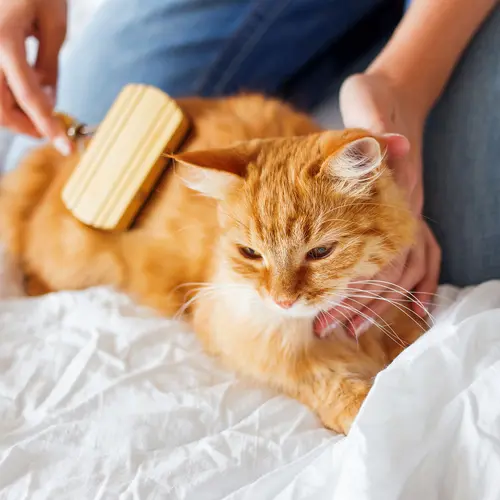The liver keeps the body healthy by helping with:
- The digestion of fats
- Hormone and protein production
- Energy regulation
- The elimination of waste products
- Regulation of immune functions
Inflammation of the liver is called hepatitis. Inflammation of the liver and biliary system is called cholangiohepatitis. Cat liver disease can cause a wide range of complications over time. That is why proper diagnosis and treatment of liver disease is essential to your cat's well-being.
What Causes Liver Disease in Cats?
The most common causes of liver disease in cats are fatty liver and inflammatory liver disease. These two conditions account for two-thirds of treated liver conditions in cats.
Fatty liver — or hepatic lipidosis — happens when fat cells build up in the liver and stop it from functioning properly. In fatty liver disease in cats, the buildup of fat cells can be fatal if not reversed. This typically occurs in overweight cats who don't eat well for a few days to a few weeks.
Inflammation in the liver can come from bacterial sources or immune-mediated deficiency, which is more common. In both cases, the inflammation and swelling prevent the correct flow of bile, which causes bile to build up in the liver, leading to significant tissue damage.
What Are the Symptoms of Liver Disease in Cats?
Symptoms of liver disease in cats include:
- Vomiting
- Diarrhea
- Constant thirst and urination
- Problems with blood clotting
- Changes in liver size
- Loss of Appetite
- Fever
- Increased thirst
- Swelling in the abdomen
- Weight loss
If the liver disease is more severe, sometimes this causes jaundice — or yellowing of the eyes, skin, and gums. The buildup of fluid in the abdominal area — or ascites — may also occur.
Sometimes with severe disease, toxins build up in the brain that the liver would normally clear. This can lead to strange behavior in your cat like disorientation, extreme salivating, or seizures. These symptoms can mimic other serious conditions like liver cancer or peritonitis, so it's important to get an accurate diagnosis.
How is Liver Disease in Cats Diagnosed?
Many blood tests can help your veterinarian determine if your cat has liver disease. Also, X-rays and ultrasounds can measure the liver size and find other irregularities.
A blood chemistry analysis, urinalysis, blood clotting ability, and analysis of bile acids may also be tested. In some cases, the liver and gallbladder may be examined by exploratory abdominal surgery.
A liver biopsy may be taken to determine the cause of the liver disease. The sample of the liver will be examined by a pathologist, and cultures may be done to rule out bacterial infection. The biopsy can be either a simple needle biopsy or a surgical biopsy. Biopsies are usually taken under anesthetic, and cannot be done on cats with clotting disorders.
What is the Treatment for Liver Disease in Cats?
Treatment for liver disease in cats is dependent on the cause. That's why a proper diagnosis is so important. If diagnosed early, cats with the bacterial form of the disease may recover after treatment with antibiotics. The immune-mediated deficiency form has a chance at long-term remission with early diagnosis and treatment.
Cats with liver disease are usually put on a high-calorie diet of easy-to-digest foods. Special attention is paid to fat and protein content. Small frequent meals are best. If the cat will not eat, IV fluids may be given for nutritional support and to prevent dehydration.
Your cat may also be put on supplements because vitamin deficiencies are often seen with liver disease. These supplements may include:
- Vitamin K
- Vitamin E
- Vitamin B
- Zinc
Follow your veterinarian’s recommendations on vitamin supplementation because overdoses of some vitamins can be harmful.
In cases of long-term liver disease, supportive treatment is prescribed to slow further disease complications. This may include giving food blended with fluids with feeding tubes, dietary support, and medications.
What is the Outlook for Cats with Liver Disease?
If the liver disease is diagnosed and treated early, cats tend to make a full recovery. But untreated liver disease can lead to more serious conditions like biliary cirrhosis — in which the bile duct is replaced by connective tissue. Acute liver failure can also occur. More than two-thirds of the liver must be severely damaged for liver failure to occur, and any intervention before this point can help prevent it.
Other complications of untreated liver disease include hepatic encephalopathy and fibrosis. Early treatment of potential liver disease in cats can lead to a healthier, longer life for your pet.

